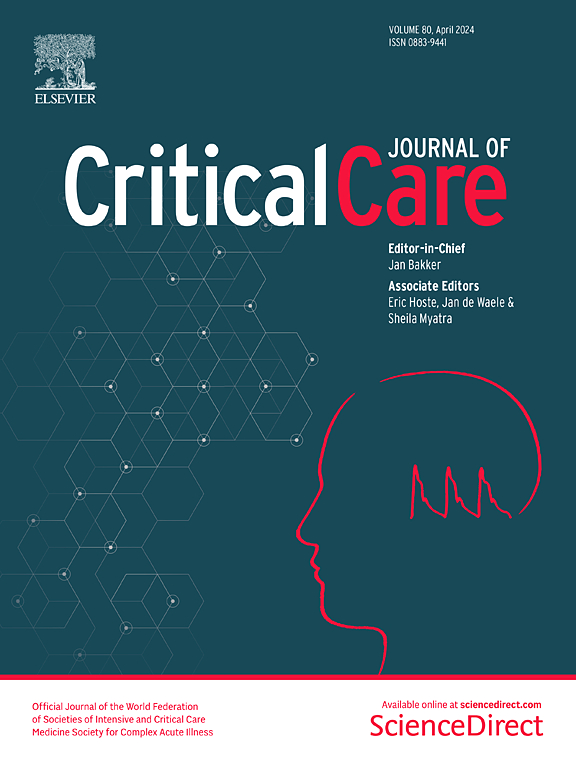Integrative multi-omics analysis unravels the host response landscape and reveals a serum protein panel for early prognosis prediction for ARDS
IF 8.8
1区 医学
Q1 CRITICAL CARE MEDICINE
引用次数: 0
Abstract
The multidimensional biological mechanisms underpinning acute respiratory distress syndrome (ARDS) continue to be elucidated, and early biomarkers for predicting ARDS prognosis are yet to be identified. We conducted a multicenter observational study, profiling the 4D-DIA proteomics and global metabolomics of serum samples collected from patients at the initial stage of ARDS, alongside samples from both disease control and healthy control groups. We identified 28-day prognosis biomarkers of ARDS in the discovery cohort using the LASSO method, fold change analysis, and the Boruta algorithm. The candidate biomarkers were validated through parallel reaction monitoring (PRM) targeted mass spectrometry in an external validation cohort. Machine learning models were applied to explore the biomarkers of ARDS prognosis. In the discovery cohort, comprising 130 adult ARDS patients (mean age 72.5, 74.6% male), 33 disease controls, and 33 healthy controls, distinct proteomic and metabolic signatures were identified to differentiate ARDS from both control groups. Pathway analysis highlighted the upregulated sphingolipid signaling pathway as a key contributor to the pathological mechanisms underlying ARDS. MAP2K1 emerged as the hub protein, facilitating interactions with various biological functions within this pathway. Additionally, the metabolite sphingosine 1-phosphate (S1P) was closely associated with ARDS and its prognosis. Our research further highlights essential pathways contributing to the deceased ARDS, such as the downregulation of hematopoietic cell lineage and calcium signaling pathways, contrasted with the upregulation of the unfolded protein response and glycolysis. In particular, GAPDH and ENO1, critical enzymes in glycolysis, showed the highest interaction degree in the protein–protein interaction network of ARDS. In the discovery cohort, a panel of 36 proteins was identified as candidate biomarkers, with 8 proteins (VCAM1, LDHB, MSN, FLG2, TAGLN2, LMNA, MBL2, and LBP) demonstrating significant consistency in an independent validation cohort of 183 patients (mean age 72.6 years, 73.2% male), confirmed by PRM assay. The protein-based model exhibited superior predictive accuracy compared to the clinical model in both the discovery cohort (AUC: 0.893 vs. 0.784; Delong test, P < 0.001) and the validation cohort (AUC: 0.802 vs. 0.738; Delong test, P = 0.008). Our multi-omics study demonstrated the potential biological mechanism and therapy targets in ARDS. This study unveiled several novel predictive biomarkers and established a validated prediction model for the poor prognosis of ARDS, offering valuable insights into the prognosis of individuals with ARDS.多组学整合分析揭示了宿主反应图谱,并揭示了用于 ARDS 早期预后预测的血清蛋白面板
急性呼吸窘迫综合征(ARDS)的多维生物机制仍有待阐明,预测 ARDS 预后的早期生物标志物也尚未确定。我们开展了一项多中心观察性研究,对采集自 ARDS 初期患者的血清样本以及疾病对照组和健康对照组样本的 4D-DIA 蛋白质组学和全球代谢组学进行了分析。我们使用 LASSO 方法、折叠变化分析和 Boruta 算法确定了发现队列中的 ARDS 28 天预后生物标志物。在外部验证队列中,通过平行反应监测(PRM)靶向质谱法对候选生物标志物进行了验证。应用机器学习模型探索 ARDS 预后的生物标志物。在由 130 名成年 ARDS 患者(平均年龄 72.5 岁,74.6% 为男性)、33 名疾病对照组和 33 名健康对照组组成的发现队列中,确定了不同的蛋白质组和代谢特征,以区分 ARDS 和两个对照组。通路分析显示,上调的鞘脂信号通路是导致 ARDS 的病理机制的关键因素。MAP2K1 成为枢纽蛋白,促进了该通路中各种生物功能的相互作用。此外,代谢物鞘磷脂(S1P)与 ARDS 及其预后密切相关。我们的研究进一步强调了导致 ARDS 死亡的重要通路,如造血细胞系和钙信号通路的下调,以及未折叠蛋白反应和糖酵解的上调。尤其是糖酵解的关键酶 GAPDH 和 ENO1,在 ARDS 蛋白-蛋白相互作用网络中显示出最高的相互作用度。在发现队列中,36 种蛋白质被确定为候选生物标志物,其中 8 种蛋白质(VCAM1、LDHB、MSN、FLG2、TAGLN2、LMNA、MBL2 和 LBP)在由 183 名患者(平均年龄 72.6 岁,73.2% 为男性)组成的独立验证队列中表现出显著的一致性,并通过 PRM 检测得到证实。在发现队列(AUC:0.893 vs. 0.784;Delong 检验,P <0.001)和验证队列(AUC:0.802 vs. 0.738;Delong 检验,P = 0.008)中,与临床模型相比,基于蛋白质的模型表现出更高的预测准确性。我们的多组学研究证明了 ARDS 潜在的生物学机制和治疗靶点。这项研究揭示了几个新的预测性生物标志物,并建立了ARDS不良预后的有效预测模型,为了解ARDS患者的预后提供了有价值的见解。
本文章由计算机程序翻译,如有差异,请以英文原文为准。
求助全文
约1分钟内获得全文
求助全文
来源期刊

Critical Care
医学-危重病医学
CiteScore
20.60
自引率
3.30%
发文量
348
审稿时长
1.5 months
期刊介绍:
Critical Care is an esteemed international medical journal that undergoes a rigorous peer-review process to maintain its high quality standards. Its primary objective is to enhance the healthcare services offered to critically ill patients. To achieve this, the journal focuses on gathering, exchanging, disseminating, and endorsing evidence-based information that is highly relevant to intensivists. By doing so, Critical Care seeks to provide a thorough and inclusive examination of the intensive care field.
文献相关原料
| 公司名称 | 产品信息 | 采购帮参考价格 |
|---|
 求助内容:
求助内容: 应助结果提醒方式:
应助结果提醒方式:


